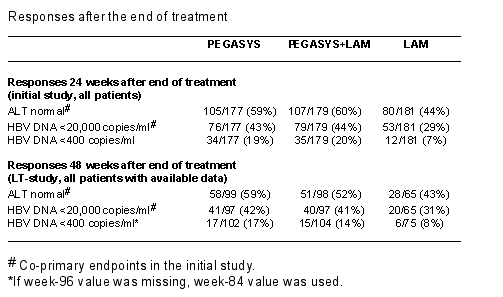 |
 |
 |
| |
SUSTAINED RESPONSE TO PEGASYS IN HBeAg-NEGATIVE CHRONIC HEPATITIS B.
|
| |
| |
1-YEAR FOLLOW-UP DATA FROM A LARGE, RANDOMISED MULTINATIONAL STUDY
This is the abstract reported at the 40th EASL meeting in Paris April 2005.
Reported by Jules Levin
P. Marcellin1, G.K.K. Lau2, F. Bonino3, P. Farci4, S. Hadziyannis5, T. Piratvisuth6, G. Germanidis7, C. Yurdaydin8, M.-Y. Lai9, N. Pluck10
1 Service d'Hˇpatologie, INSERM Unitˇ 481 and Centre de Recherches Claude Bernard sur les Hˇpatites Virales, H™pital Beaujon, Clichy, France
2 Department of Medicine, Queen Mary Hospital, University of Hong Kong, Hong Kong, China
3 IRCCS, Ospedale Maggiore di Milano Policlinico, Milan, Italy
4 Dipartimento di Scienze Mediche, Universita di Cagliari, Cagliari, Italy
5 Department of Medicine and Hepatology, Henry Dunant Hospital, Athens, Greece
6 Department of Medicine, Songklanakarin Hospital, Songkla, Thailand
7 Pathology Clinic, Papageorgiou General Hospital, Thessaloniki, Greece
8 Faculty of Medicine, University of Ankara, Ankara, Turkey
9 National Taiwan University, Taipei, Taiwan
10 Roche, Welwyn, UK
Background: Patients with HBeAg-negative chronic hepatitis B (CHB) had significantly higher rates of sustained response with peginterferon a-2a (+/_ lamivudine) than with lamivudine monotherapy [Marcellin et al, NEJM 2004].
Objectives: To assess the durability of response one year after the end of treatment.
Methods: HBeAg-negative patients received either peginterferon a-2a (180 µg once-weekly) (Pegasys) + placebo, peginterferon a-2a (Pegasys) + lamivudine (100 mg once-daily) or lamivudine. Patients were treated for 48 weeks and assessed 24 weeks after the end of treatment (initial study). All study centres were offered participation in a roll-over 5-year long-term observational study (LT-study). Preliminary results generated 48 weeks after the end of treatment (week 96) are presented.
Results: Thirteen of 54 (24%) study centres opted not to take part in the LT-study. Overall, 304 of 537 patients (57%) analysed in the initial study participated in the LT-study; more patients in the peginterferon a-2a-containing arms (63% and 62%) than in the lamivudine arm (45%) participated.
The proportion of initial study non-responders not participating in the LT-study was higher in the lamivudine arm (65%) than in the peginterferon a-2a monotherapy arm (53%).
In the initial study, normal ALT, HBV-DNA <20,000 and <400 copies/ml, all assessed 24 weeks after the end of treatment, were significantly higher with peginterferon a-2a (+/_ lamivudine) than with lamivudine (P < 0.01). Rates of response in the initial and LT-studies are presented in the table.

# Co-primary endpoints in the initial study.
*If week-96 value was missing, week-84 value was used.
Conclusions: In patients with HBeAg-negative CHB receiving peginterferon a-2a, rates of biochemical and virologic response seen one year after the end of treatment were similar to those reported 24 weeks after the end of treatment in the initial study.
A 48-week course of peginterferon a-2a (40 kDa) (PEGASYS) is able to induce high rates of sustained biochemical and virological responses one year after treatment discontinuation.
|
|
| |
| |
| |
|
 |
 |
|
|